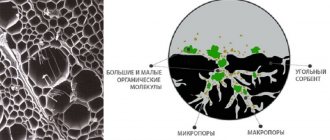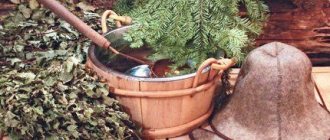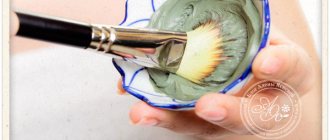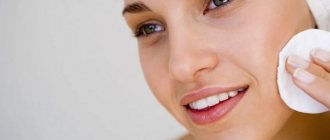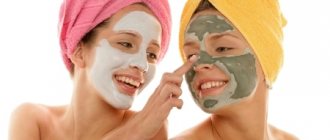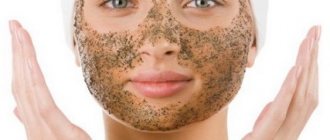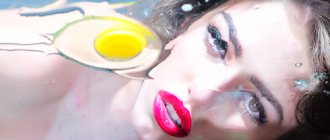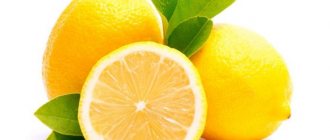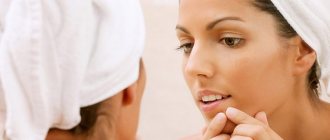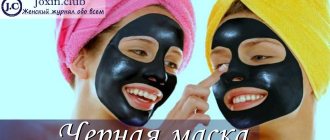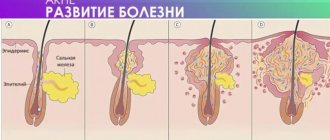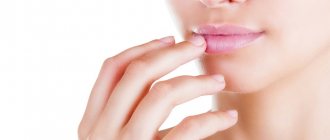Homemade masks are a budget-friendly and effective remedy for acne and blackheads. They not only eliminate rashes, but also cleanse, nourish, heal, tighten pores, and increase blood supply to cells. And some of them can even rejuvenate the skin and remove fine wrinkles.
Face masks can be done at least daily. A large selection of effective healing natural ingredients allows you to choose the perfect recipe for even the most problematic skin and adds variety to pleasant home skin care.
Causes of acne
Acne appears due to excessive production of sebaceous glands. Normally, they moisturize and protect it. But too active work of the glands leads to blockage and inflammation of the pores.
These inflamed areas are a fertile environment for the proliferation of pathogenic microorganisms. The sebum that comes out of the gland duct to the surface oxidizes and darkens. As a result, open comedones appear, or, popularly, blackheads.
When sebaceous secretions accumulate on the skin, a round white pimple is formed - a closed comedon. And the notorious acne is nothing more than an inflamed comedon.
All types of acne appear for several reasons:
- Changes in hormonal levels during puberty. The teenager’s body is subjected to a real storm of hormonal attack: the level of androgens increases abruptly, to which the skin reacts with numerous rashes.
- Increase in the amount of steroid hormones. Typically a woman's problem. Shortly before menstruation, small pimples appear on the girls’ body and face, which disappear after the end of menstruation.
- Lack of vitamin A. Lack of microelements leads to an increase in the stratum corneum of the skin - hyperkeratosis.
- Diseases of the stomach or intestines.
- Poor nutrition.
- Poor quality cosmetics or incorrectly selected skin care products.
- Regular stress and lack of sleep.
- Negative influence of external factors: cold, wind, sun, high humidity.
- Spread of infection due to squeezing pimples or using scrubs for inflamed skin or acne.
- Poor hygiene: touching the face with dirty hands, using the same towels for a long time, irregularly cleansing the face.
- Smoking. The harmful substances contained in cigarettes interfere with normal blood flow and nutrition of the epidermis.
If acne regularly appears in a certain area of the face, you can determine the potential cause of the rash:
- A rash on the chin indicates a malfunction of the thyroid gland, intestines, reproductive system, or a recent cold.
- Pimples on the forehead indicate diseases of the stomach, pancreas, bladder or intestines.
- Near the lips, I indicate serious problems in the functioning of the entire digestive system.
- Rashes on the nose are associated with overly enlarged pores or hormonal imbalance. Also, the appearance of acne in this area may indicate problems with the cardiovascular system. But rashes on the bridge of the nose are a signal of liver problems.
In what cases is the procedure contraindicated?
Dermatologists strongly advise against self-medication and using homemade masks in the following cases:
- extensive and severe purulent inflammatory processes on the skin of the face;
- source of acne formation associated with internal organ disease;
- individual intolerance to one of the active ingredients of the recipe;
- acne affected areas, comprising more than 25% of the entire skin surface on the face.
You cannot squeeze out acne on your own, as you can get even more infected skin and aggravate the situation when the face becomes completely covered with entire conglomerates of rashes, leaving behind disfiguring scars and welts!
Foods that cause acne
The first advice dermatologists give to people suffering from skin rashes is to reconsider their diet. Ignoring healthy foods and overindulging in junk food is a major factor in the development of acne.
To get rid of the rash, you need to give up only 6 types of foods:
- Coffee. This drink increases levels of cortisol, a stress hormone that thins and ages the skin.
- Sweets and baked goods. The ban includes not only confectionery products, but also sweet carbonated drinks and store-bought juices.
- A range of dairy products. Cheeses, ice cream, artificial yoghurts and curds with added dyes and flavor enhancers have a negative impact on the condition of the skin.
- Animal fats and fried heavy foods. Such food disrupts the normal functioning of the intestines, which causes problems with skin rashes.
- Fast food. Food in fast food establishments, crackers, chips, salted nuts are the first enemies of healthy skin.
- Alcohol. It increases skin oiliness and disrupts metabolic processes.
Shave without acne
Shaving can be both a plus and a minus for men's problem skin. The benefit is that daily shaving acts as a natural exfoliant.
But if you do it wrong or use the wrong products, you may end up with more acne. Use Epideryl® Demodex moisturizer, lotion or foam.” These products promote gentle cleansing, moisturizing, tissue regeneration and provide antioxidant protection.
Essential oils for acne
The use of essential oils for acne
Essential oils have become widespread not only in medicine, but also in cosmetology. They are added to basic skin, hair and nail care products. Each of them has its own effect on appearance, and some effectively affect acne:
- Tea tree oil. It has healing, soothing, anti-edematous and antimicrobial properties.
- Rosemary oil . Dissolves pus, kills bacteria, tightens pores and smoothes expression lines. It is applied directly to pimples.
- Lavender oil. Slows down aging, neutralizes fungus, eliminates flaking and relieves itching. It dries out pimples, so you need to lubricate the problem area itself.
- Citrus oil - lemon, orange or grapefruit. Heals wounds, whitens and smoothes the skin, normalizes metabolic processes. Effective in the fight against regular rashes, freckles, age spots.
- Peppermint ether. A good anti-inflammatory agent. In addition to the rash, it removes capillary mesh, relieves redness and itching.
- Bergamot oil. Evens out skin tone, regulates the production of sebaceous secretions, and tightens pores. Acne is lubricated with this oil 1 – 2 times a day.
- Clove oil. Antibacterial and healing agent, effectively regulates the production of sebaceous secretions.
- Eucalyptus oil. It whitens the skin well, relieves inflammation and neutralizes bacteria. It is recommended for severe acne.
What to do with remaining scars on the skin
Curing annoying pimples is not everything, because after removing them, unsightly scars may remain on the skin. Fortunately, there are many different methods, including folk remedies, for removing acne marks and blackheads. Let's look at some of them.
- Sandalwood paste
. This is perhaps one of the most effective products for removing remaining marks on the skin. To prepare this paste, you need to soak a small amount of sandalwood powder in clean water or milk and leave it overnight. The finished product is applied to problem areas of the skin and washed off only after complete drying. As a rule, the paste dries in 10 minutes. - Lemon juice
. It is also effective as a treatment for acne scars. You need to gently rub lemon juice into your skin. If necessary, dilute the juice in water, as it is a rather aggressive substance. Lemon juice can also be used as a skin cleanser. - Parsley decoction
. Pour 2-3 tbsp. l. crushed plant with boiling water and leave for 3 hours. Pour the prepared and cooled broth into small molds and place in the freezer. Wipe your face with the resulting ice cubes every day for two months. This will cleanse and refresh your facial skin.
If you are not satisfied with folk remedies, then you can use drug treatment. In this case, a complex drug that accelerates the skin healing process is best suited. As a rule, such drugs are produced in the form of a gel or ointment. You just need to choose the most suitable remedy at the pharmacy.
How to remove acne at home
Among all the home remedies for acne, face masks are considered the best. They not only gently cleanse the skin, but also treat inflammation, nourish cells, and normalize metabolic processes in tissues.
Egg white face mask for blackheads and pimples
Egg white mask
A simple and effective way to get rid of acne is an egg white mask. It not only treats rashes but also tightens and rejuvenates the skin. For a classic mask you will need raw protein. It should be separated from the yolk, whipped to a standing foam and applied to the face. When the mass hardens, wash your face with warm water. For greater efficiency, you can add honey, essential or vegetable oils to the whipped protein.
Yeast anti-acne face mask
This mask is ideal for oily skin. It removes excess oil, cleanses pores and effectively fights acne and blackheads. For this natural mask, take 50 g of dry yeast, dilute it in 40 ml of clean water and mix thoroughly. Apply to the face, leave for 20 minutes and wash off without soap.
Honey mask
Honey masks are an excellent cleansing method. The viscous natural sweetness is like a sponge absorbing all impurities. In addition, honey soothes and disinfects the skin. And a large number of useful microelements nourish the epidermis with essential vitamins and amino acids. The easiest way is to simply apply honey to the skin, leave for 15 minutes and rinse. By the way, if you alternately apply it to your face and tear off your fingers before removing the treatment mask, you can do a good peeling at the same time.
To make the mask more effective for a specific skin type, various ingredients are added to honey:
- Lemon juice removes excess oil and eliminates shine.
- Olive oil and egg yolk moisturize dry skin.
- For problematic skin, a soft cleansing mask with the addition of cucumber juice is suitable.
Cleansing mask for acne and blackheads with gelatin
An anti-acne mask with gelatin can compete with professional salon products. It cleanses, tightens the skin, removes wrinkles and gets rid of acne.
To prepare it you will need gelatin without dyes and water. The last ingredient can be replaced with natural juice. The components should be mixed in a ratio of 1:5 and heated in a water bath. This natural mask is applied evenly to the face and neck, wait until it hardens, and then pick it up with your finger and carefully remove it.
After the first use, blackheads will disappear, the skin will become more elastic, and after a while the rash will disappear.
Oatmeal face mask for acne and blackheads
Oatmeal is an excellent product for nourishing and cleansing the skin. It has rejuvenating, peeling and matting properties.
To prepare a therapeutic mask for acne, take oatmeal flakes (the same “Hercules”), grind them to particles and mix them with other ingredients. Components are selected based on skin type. For fatty ones use honey, protein or kefir, for dry ones - yolk, sour cream, vegetable oil.
Face mask for acne and blackheads with soda
Face masks with baking soda are the most effective cleanser. They are used against open comedones on the nose, forehead, and chin. This mask relieves inflammation and has an antibacterial effect.
For the mask, 1 spoon of soda is diluted with 50 - 60 ml of warm water. Apply to the skin and gently massage problem areas. Afterwards, wash off without using soap. Those with sensitive skin add cream, sour cream or yolk to this cleansing mask.
Carrot mask
The main benefit of carrot-based face masks is not cleansing, but nourishing the skin. Such products are truly healing: they supply cells with essential nutrients, in particular vitamin A, the main micronutrient for healthy skin.
For this natural mask you will need 2 tablespoons of grated carrots, 20 ml of honey and one egg. The mixture is kept for 15 minutes, then the skin is cleansed.
Features of application
To eliminate acne, you need to use therapeutic masks according to certain rules:
- Before applying the product, be sure to check it for allergies. To do this, apply a small amount of the prepared mixture to your wrist. If no reaction follows, then the mask can be applied to the face;
- along with the use of masks, if possible, adjust your diet by excluding spicy and fatty foods;
- If the inflammatory process develops, immediately seek help from a doctor. In this case, you need to contact a dermatologist.
Following these simple rules will make the treatment of acne on the face and other areas of the skin more effective.
How to make an anti-acne mask correctly
Anti-acne masks will become more effective if you follow several rules for use:
- Before application, the skin is cleansed and steamed in a warm bath with the addition of aromatic oils.
- Each new component is pre-tested for a possible allergic reaction: the mixture is applied to the crook of the elbow and, if after 2-3 hours no itching, rash or redness appears, it is used as directed.
- Masks by themselves are not able to cope with all problems: first of all, you need to review your diet and make sure that the rash is not caused by a disease.
- Before and after the procedure, you should not squeeze pimples - this contributes to the spread of infection.
Contraindications
Despite the enormous benefits of anti-acne masks, they are not recommended for use in some cases:
- For open wounds and cuts.
- Skin dehydration and excessive dryness.
- Purulent nature of the rashes.
- If acne covers more than a third of the face.
- Possible allergic reactions.
Acne masks are not a panacea. Complete relief from the rash is only possible with comprehensive drug treatment and elimination of internal diseases.
Prevention of acne on the face
Healthy eating and sleep are integral components of the prevention of any disease. You should also exclude specific foods that cause allergic reactions in a person. Excessive consumption of sweets can lead to acne.
Maintaining good hygiene is essential to maintaining a clean face. It is recommended to change bed linen (in extreme cases, pillowcases) once a week; you should try to touch your face less often during the day (especially with dirty hands). The screen of mobile phones is a large accumulation of bacteria, so it is recommended to keep it at some distance from your face while talking.
The skin needs to be given some rest from cosmetics. You should not overdo it with decorative cosmetics, or at least you should try to look for products labeled “non-comedogenic”. If your skin is prone to inflammation, you should choose cosmetics for the problem type. If the problem occurs from time to time, it is recommended to use spot application products. “For oily-prone skin”, cosmetics with mattifying ingredients that help regulate the activity of the sebaceous glands are suitable. These include: seaweed, charcoal, green tea extract, salicylic acid and zinc. For the “combined” type, the following are suitable: grape extract, aloe, hyaluronic acid, black algae.
Makeup for acne
People have been hiding pimples for centuries. In the 1600s, women wore silk ribbons shaped like stars and the moon to hide smallpox scars. Today, makeup is used to cover up acne, but applying layer after layer of products is not the best solution.
Makeup can hide pimples, but it can also highlight them if cosmetic products are applied too thickly. The redness and flaking that remains after many acne treatments can look even worse when covered with a heavy layer of makeup.
If you notice that your skin becomes red, itchy, or swollen after using a certain type of cosmetic, stop using it. Some cosmetic ingredients cause an allergic irritation known as contact dermatitis.
